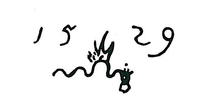Lucas Cranach the Elder
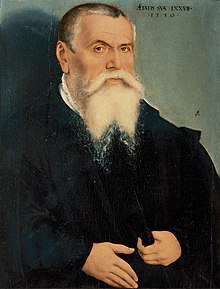
Lucas Cranach the Elder (* probably around October 4, 1472 in Kronach , Upper Franconia ; † October 16, 1553 in Weimar ) was one of the most important German painters , graphic artists and book printers of the Renaissance . From 1505 he was court painter at the Electoral Saxon court under Friedrich the Wise , Johann the Steadfast and Johann Friedrich the Magnanimous . In addition to numerous altarpieces and allegorical paintings, he and his workshop also made a large number of portraits of his employers and the reformers Martin Luther and Philipp Melanchthon . The Cranach workshop, which is believed to have left around 5,000 paintings, was continued by his son of the same name, Lucas Cranach the Younger .
resume

The chronicler Matthias Gunderam reported in 1556 that Cranach was born on October 4th, 1472 in Kronach and that he received his first artistic training from his father, the wealthy Kronach citizen Hans Maler, whose wife Barbara was a née Hübner. There is no documentary evidence of Cranach's origin or his date of birth. Based on court files from 1495, which deal with the bad behavior of the painter's children, the year of birth 1472 is doubted by recent research and only vaguely dated to "around 1475".
Cranach had at least six sisters and two brothers. Her mother Barbara died around 1491. After his initial artistic training, Lucas probably went on a journey as a journeyman. In 1502 he came to Vienna and stayed there until 1504. Because of the imperial court, Maximilians I , Vienna was considered the cultural center of that time, where there were also contacts to numerous princes as potential employers and clients. The paintings from this period show clear influences from the Danube School . In Vienna he made his first contacts with leading humanists . During his stay in Vienna, Cranach began to sign his pictures with Lucas Cranach ("Lucas [from] Kronach").
In 1505 he got a job as a court painter to the Elector Frederick the Wise of Saxony in Wittenberg . He took over the painter's workshop in Wittenberg Castle , previously headed by Jacopo de 'Barbari , whose tasks included not only furnishing churches and castles with paintings, but also making book decorations as well as trivial painting, gilding and designing festive decorations and ornaments. Impressive evidence of the birth of medal art in Germany are, for example, the so-called Locumtenenstaler with the likeness of Frederick the Wise, for which he provided the design. Numerous invoices received provide information about the type and scope of the activities.
As a court painter, Cranach made numerous portraits of his employer, the first time in 1507 for the Nuremberg Dominican Church .
With effect from January 6, 1508, Cranach was given an emblem (with a winged serpent with a ruby ring in its mouth) as a family coat of arms by his employer. In the same year he was sent to the Netherlands (to Mechelen ) on a diplomatic assignment by the Elector , where he - along with other members of the family - made portraits of Emperor Maximilian I and the later Emperor Charles V.
In 1510, special payments from Lucas Moler are mentioned for the first time in documents from the city of Wittenberg . He also bought various building materials that year. From this it is concluded that he and the workshop moved from the castle to the city that year. Around 1512/13 Cranach married Barbara Brengbier († 1541), a daughter of Jobst Brengbier, the mayor of Gotha . His eldest son Hans was born and Lucas was born in 1515 , followed by three daughters by 1520. Around 1513 start of a wine bar. In the years 1515 to 1520 he created the first prints ( woodcuts etc.), some of which - similar to Albrecht Dürer - he distributed himself freely.
In 1520 he was able to buy a pharmacy in Wittenberg, a few years later he is also known as a bookseller, paper dealer and publisher. Together with his business partner, the goldsmith Christian Döring , he oversaw the publishing of Martin Luther's September will in 1522 . He became a respected and influential figure in his new home - also as a landowner and publisher. In 1524 he met Albrecht Dürer in Nuremberg ; on this occasion Dürer made a portrait of Cranach in silver pen. Cranach first came to the Wittenberg council chair as treasurer in the period of office of 1519/1520 and held this office repeatedly until 1535. Furthermore, he was a member of the council for the period of office 1528/1529.
In Wittenberg he made friends with Philipp Melanchthon and Martin Luther. Together with his wife, he was the best man at his marriage to Katharina von Bora in 1525 and was godfather of Luther's eldest son Johannes. The second wife of his son Lucas, Magdalena Schurff, was a niece of Philipp Melanchthon. Cranach not only developed into the characteristic painter of the German Reformation , he also worked nationwide in the intellectual debate of this time through his graphics in Reformation writings. However, he was not only active for Reformation-minded clients, but also for Old Believers. For example, he created the extensive altar cycle for Cardinal Albrecht's new collegiate church in Halle.
After the death of Frederick the Wise, Cranach was employed as court painter by his successors Johann the Steadfast and Johann Friedrich the Magnanimous . In addition to mostly unknown employees, his two sons Hans and Lucas the Elder were also involved from around 1530. J. worked in the Cranach workshop. From 1537 to 1544, Lucas Cranach was repeatedly at the head of the Wittenberg community as mayor and also held the office of assessor of a mayor as a former mayor several times.
With the city council, Cranach advocated the execution of Prista Frühbottin , her son Dictus and two other people for witchcraft ; they were smoked. The verdict was passed by the city judge Ambrosius Reuther and Lucas Cranach the Elder. Ä. confirmed the verdict as mayor. On Tuesday, June 29, 1540, the old woman and her fellow delinquents were executed. About the witch burning in Wittenberg in 1540 Lucas Cranach the Elder created J. a woodcut .

In 1547 his third employer, Duke Johann Friedrich the Magnanimous, succumbed to the imperial troops in the Battle of Mühlberg and was imprisoned. At Johann Friedrich's request, Cranach followed him three years later into captivity in Augsburg , then in Innsbruck. There, too, he worked for the duke and his visitors - he had meanwhile handed over his Wittenberg workshop to his son Lucas. In Augsburg he made the acquaintance of Titian .
In 1552 Lucas Cranach the Elder went with the Duke to his new residence in Weimar . There he lived in the house of his daughter Barbara Cranach (the " Cranachhaus "). He died on October 16, 1553.
He found his final resting place in the Jakobsfriedhof in Weimar . On his tombstone he is described as "the fastest painter". The tombstone was created by Cranach's friend, the ducal master builder and trained stonemason, Nikolaus Gromann . The tombstone that today's visitor sees is a true copy of the original. The original grave plate was replaced by a copy and, for conservation reasons, moved to the city church of Peter and Paul ("Herderkirche") to the left of the altar in 1859.
progeny
Cranach had five children with his wife Barbara:
- Hans (* around 1512; † 1537), who also became an artist
- Lucas (* 1515; † 1586), known as "the Younger", took over his father's workshop in 1550 (1552?) And, like him, also became a council member and mayor of Wittenberg. The grandson Augustin (1554–1595) and great grandson Lucas (1586–1645) continued the artistic family tradition.
- Barbara († 1601), married to the Saxon Chancellor Christian Brück since 1543 . The mother of the poet Johann Wolfgang von Goethe comes from this line , so that Lucas Cranach is the great-great-grandfather of Goethe.
- Ursula (life data unknown), first marriage on May 3, 1537 (husband unknown), second marriage in 1544 with the Gotha mayor Georg Dasch
- Anna (* unknown; † June 30, 1577), married to the Wittenberg pharmacist and mayor Caspar Pfreund
plant
power
Lucas Cranach is one of the most important visual artists of the early 16th century in Germany. Since he held the permanent position as court painter to the Saxon electors in 1505, he also worked for Emperor Maximilian I , for Albrecht of Brandenburg , Albrecht's brother Joachim I Nestor and his son Joachim II of Brandenburg, as well as for other high nobles and - at the same time - for his Protestant friends. Together with Albrecht Dürer and other important artists of the time, he received the honorable commission in 1515 to illustrate Maximilian I's prayer book .
The indirect influence of his great Nuremberg colleague can be found in many of his works. However, Cranach was less interested in dealing with classic Italian forms than Dürer, but rather remained within northern Alpine design: he switched from the innovations of the Danube School to Low German traditions. Cranach became particularly well known for his secular and allegorical nudes, which were completely new in German painting.
Cardinal Albrecht von Brandenburg and Martin Luther stand for the conflict between Old Believer Catholics and Reformation Protestants - the artist Lucas Cranach in between. He made no secret of his sympathy for Luther and the Reformation, and although Cranach's graphics played a decisive role in the spread of Reformation ideas (Luther's translation of the Bible with Cranach's illustrations appeared in 1522), he always worked - with success - for Catholic clients, especially for Albrecht von Brandenburg or the Albertine Duke George the Bearded . The Cranach workshop completed the most extensive cycle of paintings in German art history for the new collegiate church in Albrecht's favorite residence, Halle . On the other hand, Cranach developed new topics for his Protestant clients that focused on the concept of divine grace or the justification of sinful people through faith.
Even his contemporaries were amazed by the productivity of Cranach. Following the example of his Italian colleagues, he had set up a very well-organized workshop in which successful samples were kept and used for later orders. Templates were used for various portraits of princes and reformers, which were then adapted to the aged appearance of the portrayed (e.g. George the Bearded, Friedrich the Wise, Martin Luther) by changing the length of the beard or graying hair. Numerous small-scale design drawings have been preserved for altar works, which could be exchanged like a modular system when designing an altar. His numerous apprentices and journeymen were subject to strict discipline. This led to a standardized style that made it difficult to divorce hands between him, his sons and co-workers, and imitators.
Work overview
It is believed that up to 5,000 paintings could have been created by the artist and his workshop. In museums, collections and on the art market, well over 1,000 panel paintings can still be found today. The Weimar curator Christian Schuchardt described several hundred paintings in his work on the life and work of Cranach, which appeared in three volumes between 1851 and 1871. In 1863 Gustav Parthey listed in his directory of oil paintings by deceased painters from all schools in Germany 357 paintings ascribed to the older Cranach as well as around 400 other works that could be considered for the younger Cranach, both or both workshops and schools. Around 850 paintings by Max J. Friedländer and Jakob Rosenberg were compiled and commented on in 1932 (re-published in 1979). Many individual panels, unless they are portraits or allegorical representations, were once parts of extensive altar works, of which the largest number can only be verified by documents. Some Cranach altars could be reconstructed as a whole (e.g. Magdalene Altar) or in fragments (e.g. Prague Altar).
In addition to panel paintings, there are a large number of woodcuts, around 350 drawings and several copper engravings. The drawings were dealt with by Girshausen in 1936, by Rosenberg in 1960 and most recently by Hofbauer in 2010. A far-reaching overview of their entire oeuvre was presented by Koepplin / Falk in the Basel catalog 1974/76. There are also numerous publications on individual holdings, e.g. B. a catalog of around 80 drawings in Erlangen or a catalog of the Dresden Cranach inventory. The compilation of the complete works remained a desideratum until the end of the 20th century . A catalog raisonné was only possible with the introduction of new media. In its Cranach catalog raisonné Corpus Cranach , which was presented for the first time in 2014 and has been continued since then, Heidelberg University Library lists more than 2,500 paintings, a large part of which were for Cranach the Elder. Ä. come into question.
The work of the older Cranach extends over a period of more than five decades. According to the latest research, the portrait of a young man (shown on the earlier ten D-Mark note ), which was previously attributed to Albrecht Dürer , is one of the earliest works by Lucas Cranach from shortly before 1500. The last work is the altarpiece for the city church of Weimar, which the elder Cranach probably started in 1552 and which his son Lucas the Elder wrote. J. 1555 was completed.
Works (selection)
Works by Lucas Cranach the Elder from a creative phase from 1502 to 1555.
| Illustration | Title (year of creation) | Repository |
|---|---|---|

|
Crucifixion Kalvarienberg "Schottenkreuzigung" (around 1500) |
Kunsthistorisches Museum Vienna |

|
Saint Valentine with donor (1502/03) |
Academy of Fine Arts Vienna |

|
Lament under the cross "Schleissheimer Kreuzigung" (1503) |
Old Pinakothek Munich |
 
|
Spouses portraits of a scholar and his wife (1503) |
Germanisches Nationalmuseum in Nuremberg and Gemäldegalerie in Berlin |
 
|
Spouses portraits of Dr. Johannes Cuspinian and Anna Cuspinian (née Putsch) (1503) |
Oskar Reinhart Collection "Am Römerholz" Winterthur |

|
Holy Family in Landscape "Rest on the Flight" (1504) |
Gemäldegalerie in Berlin |

|
The martyrdom of St. Catherine - middle picture of the Dresden winged altar (1506) |
Old Masters Picture Gallery Dresden |
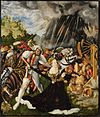
|
The Martyrdom of Saint Catherine (1508) |
Raday Collection of the Budapest Reformed Church |

|
Venus and Cupid (1509) |
Hermitage Saint Petersburg |

|
Christoph Scheurl (1509) |
Wittenberg |

|
Small winged altar "Travel Altar" (around 1509/10) |
Old Masters Picture Gallery (Kassel) Kassel |

|
Prince's altar "Torgau Altar" (1509) |
Städelsches Kunstinstitut Frankfurt am Main |

|
The Martyrdom of Saint Barbara (around 1510) |
Metropolitan Museum of Art New York City |
| Prince altar (around 1510) |
Dessau | |

|
Madonna under the firs (around 1510) |
Wroclaw |

|
Salome (around 1510) |
Museu Nacional de Arte Antiga Lisbon |

|
Winged altar "Neustädter Altar" (1512/13) |
City church St. Johannis Neustadt an der Orla |

|
Adam and Eve (around 1513/15) |
Museum for Franconia Würzburg |

|
Portrait couple Heinrich the Pious and Katharina von Mecklenburg (1514) |
Old Masters Picture Gallery Dresden |

|
Christ and Mary (1515/20) |
Gotha |
|
|
Ten Commandments Tablet (1516) |
Wittenberg |

|
Adam and Eve (around 1518) |
Duke Anton Ulrich Museum Braunschweig |

|
The dying, epitaph of Heinrich Schmitburg (1518) |
Museum of Fine Arts Leipzig |

|
Reclining spring nymph (1518) |
Leipzig |

|
Saint Eustachius adoring before the stag of Christ (around 1515/20) |
Vaduz |
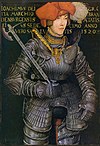
|
Elector Joachim II of Brandenburg (around 1520) |
Grunewald Hunting Lodge, Berlin |

|
Prince Johann von Anhalt (around 1520) |
Grunewald Hunting Lodge, Berlin |

|
Christophorus (1516) |
Detroit |

|
Diana and Actaeon (first third of the 16th century) |
Franconian Gallery Kronach |

|
Half figure of Judith | (Loss of war) |
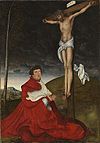
|
Cardinal Albrecht of Brandenburg kneeling before the crucified (around 1520) |
Munich |

|
Christ and the Adulteress (around 1520) |
Franconian Gallery Kronach |

|
Magdalene Altar (1520-25) |
Aschaffenburg Abbey Museum |

|
Martin Luther as Junker Jörg (1521) |
Museum of Fine Arts Leipzig |
| Christ as the Man of Sorrows at the open grave (1524) |
Augustinermuseum Freiburg im Breisgau |
|

|
Judith with two companions (1525) |
Gustav Rau Collection |
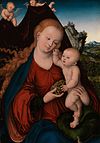
|
Grape Madonna (around 1525) |
Munich |

|
Princess Sibylle of Cleve as a bride (1526) |
Weimar City Palace |

|
Saint Anthony as a hermit (around 1520/25) |
Leitmeritz |

|
Cardinal Albrecht of Brandenburg as Hieronymus in the case (1525) | Hessian State Museum Darmstadt |
 
|
Portrait couple of Martin Luther's parents Hans Luther and Magarethe Luther (1527) |
Eisenach |

|
Hans Luther (opaque color drawing) (1527) |
Vienna |
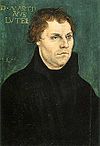 
|
Portrait couple Martin Luther and Katharina von Bora (around 1526) |
Private ownership, Hamburg |
 
|
Portrait couple Martin Luther and Katharina von Bora (1526) |
Eisenach |
 
|
Portrait couple Martin Luther and Katharina von Bora (1528) |
Lower Saxony State Museum Hanover |

|
The judgment of Paris (1528) |
Art Museum Basel |

|
Martin Luther | Gemäldegalerie in Berlin |
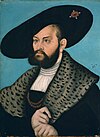
|
Duke Albrecht of Brandenburg-Ansbach (1528) |
Duke Anton Ulrich Museum Braunschweig |

|
Law and grace (1529) |
Friedenstein Castle Gotha |

|
Triptych (1529) by Simon Franck completed |
Marktkirche Our Dear Women Hall on the Saale |

|
Portrait of Johannes Scheyring (1529) |
Royal Museums of Fine Arts of Brussels |

|
Elector Joachim I of Brandenburg (1529) |
Grunewald Hunting Lodge, Berlin |

|
Margrave Georg the Pious of Brandenburg-Ansbach with headgear (1529) |
Grunewald Hunting Lodge, Berlin |

|
Margrave Georg the Pious of Brandenburg-Ansbach without headgear (1529) |
Grunewald Hunting Lodge, Berlin |

|
Cardinal Albrecht of Brandenburg (1529) |
Grunewald Hunting Lodge, Berlin |

|
Double portrait of Martin Luther and his wife Katharina Bora (around 1529) |
Museo Poldi Pezzoli Milan |

|
Judith with the head of Holofernes (around 1530) |
State Gallery Stuttgart |

|
Judith with the head of Holofernes (1530) |
Grunewald Hunting Lodge, Berlin |

|
Three Graces (around 1530) |
Cambridge |

|
The golden age (around 1530) |
Oslo |

|
The golden age (around 1530) |
Munich |

|
The Fruits of Jealousy (The End of the Silver Age) (around 1530) |
National Gallery London |

|
Saint Barbara (around 1530) |
Würth Collection, Johanniter Church in Schwäbisch Hall |

|
Judgment of Paris (1530) |
Karlsruhe Art Gallery |

|
Melancholy (1532) |
Colmar |

|
Venus (1532) |
Städelsches Kunstinstitut Frankfurt am Main |
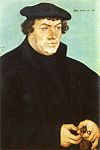
|
Portrait of a man (previously interpreted as Johannes Bugenhagen , but according to recent research it is more likely to be the Leipzig reformer Christoph Ering ) (1532) |
Hamburg |

|
Frederick the Wise (1532) |
Franconian Gallery Kronach |

|
John the Steadfast (1532) |
Franconian Gallery Kronach |

|
John the Steadfast (1532) |
Weimar |

|
John the Steadfast (1532) |
Hamburg |
|
|
The three electors of Saxony (1532) |
Hamburg |

|
Johann Friedrich the Magnanimous of Saxony (1533) |
Tokyo |

|
Payment (1532) |
National Museum Stockholm |
| Adam and Eve
(1525-1530) |
Warsaw Royal Castle | |

|
Adam and Eve (1533) |
Museum of Fine Arts Leipzig |

|
Gregor Brück (1533) |
Germanic National Museum Nuremberg |

|
Venus and Cupid as a honey thief (1534) |
Franconian Gallery Kronach |

|
Portrait of a Lady with a Feathered Hat (1534) |
New residence in Bamberg |

|
The Princesses Sidonie von Sachsen , Aemilia von Sachsen and Sibylle von Sachsen (around 1535) |
Kunsthistorisches Museum Vienna |

|
The captain under the cross (1536) |
Washington |

|
Justice as a Naked Woman with Sword and Scales (1537) |
Amsterdam |

|
Caritas 1537 |
Hamburger Kunsthalle |

|
Portrait of a Young Woman. Princess Emilia of Saxony? (around 1537) |
Ny Carlsberg Glyptotek Copenhagen |
| Winged altar (crucifixion of Christ) for St. Alexandri in Einbeck |
Kreuzkirche Hannover and Lower Saxony State Museum Hannover |
|

|
Hercules at Omphale (1537) |
Duke Anton Ulrich Museum Braunschweig |

|
Venus with Cupid as a honey thief (1537) |
National Gallery London |
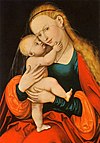
|
Image of grace Mariahilf (after 1537) |
Innsbruck Cathedral |

|
The captain under the cross (1538) |
Seville |

|
Schneeberger Altar (1532–1539) |
St. Wolfgang Church in Schneeberg |

|
The Deer Hunt (1540) |
Cleveland |
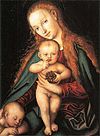
|
Mary with the Christ child and the sleeping John boy (around 1540/50) |
Privately owned |

|
Crucifixion Altar (1540) |
State Gallery Aschaffenburg |
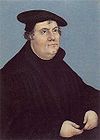 
|
Portrait couple Martin Luther and Philipp Melanchthon (1543) |
Hamburg |

|
Deer and boar hunting (1544) |
|

|
Christ blesses the children (1546) |
Collection Würth Johanniterkirche Schwäbisch Hall |

|
Reformation altar (construction: around 1540; inauguration: 1547) |
City Church St. Marien Wittenberg |

|
Lucretia first half of the 16th century |
Historical Museum Regensburg |

|
Portrait at the age of 77 (self-portrait or work by Cranach the Younger) (1550) |
Uffizi Gallery, Florence |

|
Christ on the Cross altarpiece, begun in 1552; by Lucas Cranach the Elder J. completed in 1555 (1552-55) |
City Church Weimar | - |
| Reclining female nude with child | formerly the Dresden Kupferstichkabinett , now lost |
Problems of attribution
According to the traditional works and biographical data, Lukas Cranach emerged from the darkness of history around 1500 as a trained painter. One can only speculate about his education. The work ascribed to him goes through several changes. While his early work still shows influences from the Danube School, Italian and other influences have also been added over time. The long working life of the Cranach workshop with generations of employees who have worked through it over several decades reveals a large number of different artist hands within the overall work, without these being clearly divorced.
Very few employees in the Cranach workshop are known by name. From 1538 to 1541 Franz Tymmermann was a pupil of the older Cranach, with the younger Cranach from 1550 to 1555 Heinrich Königswieser , 1565 to 1568 Erhard Gaulrap and from 1571 Zacharias Wehme are recorded . From other painters like Wolfgang Krodel the Elder. Ä. or Augustus Cordus , based on stylistic similarities, it is assumed that they also received their training from Cranach.
Cranach's signature, the winged snake that he used when Frederick the Wise was awarded the coat of arms at the beginning of 1508, is found on the surviving works in such a variety that it can no longer be interpreted today. Essentially, a distinction can only be made between the position of the serpent's wings (standing or lowered), which is usually used to limit the time before or after the death of his son Hans in 1537. With many works it is not even possible to give them to older Cranach or his son Lukas the Elder. J. assign.
The traditional way of attribution is therefore such that the highest quality of the works are ascribed to the older Cranach and the others in the order of their quality gradient to his son Lukas, the workshop or the circle or the successor. In the end, many of the traditional works, including the small-format portraits of the elector and reformers, were mass-produced products, which, according to the invoices received, were manufactured in large numbers by the Cranach workshop and intended to be widely distributed.
An attribution is therefore extremely difficult. Many of the works that are used by Cranach today were still attributed to Mathias Grünewald in the 19th century , while other works that were once attributed to Cranach are now more likely to be attributed to the Schneeberg artist family Krodel or the copyist Christian Richter. The master of the Pflock Altar, known only by his emergency name, can also be identified as the painter in charge of an important group of works . It is the same with the master of the Gregor masses . Other works once attributed to Cranach are by the painter Franz Wolfgang Rohrich , who created numerous paintings in the Renaissance style in the early 19th century.
Further attribution problems arise from the fact that some of Cranach's pictorial ideas soon acquired an iconographic character and were soon copied many times after their creation, including the portraits of Luther and the portraits of the Saxon electors or the miraculous image of Mariahilf, which is widely used in countless copies throughout the Alpine region . For some of the late repetitions of Cranach's motifs, Cranach's grandson Augustin Cranach or great-grandson Lucas Cranach III. those who continued the family tradition of painting, but to which research has so far only been able to assign very few works.
The value of the Cranach paintings on the art market and their extremely difficult attribution also continue to attract forgers and fraudsters, who either create new forgeries or declare insignificant paintings with corresponding motifs to be real Cranachs. For example, the panel with Frederick the Wise with imperial crown from the Limacon Foundation's art collection caused a stir , the value of which was estimated at ten million US dollars in 2001, but which was later regarded as a minor work by the Cranach successor . The artist Christian Goller is considered to be the originator of a large number of modern Cranach forgeries. He and his assistants brought at least 40 Cranach imitations onto the market and, according to LKA President Peter Dathe, "intervened in German art history". A depiction of Venus, which Hans-Adam II von und zu Liechtenstein acquired in 2013 as a work of Cranach the Elder from the London art dealer Colnaghi for 7 million euros , was confiscated by the French police in March 2016 after doubts about the authenticity of the Painting had come up.
souvenir
Memorials
- Cranach memorial by the sculptor Frijo Müller-Belecke and memorial plaque in the Cranachhof in Lutherstadt Wittenberg
- Relief medallion in the Wittenberg Castle Church
- Monument in the Marienkirche in Zwickau created in 1890/91
- Monument bust in Weimar created by Adolph Donndorf in 1886
- Bust in the Hall of Fame in Munich
- Half figure in Kronach
Naming schools and streets
After Lucas Cranach, elementary schools in his native Kronach and his places of work Weimar and Lutherstadt Wittenberg (grammar school) as well as a community elementary school on the southern edge of the city of Essen are named. In Groß Flottbek (today Hamburg-Groß Flottbek ), Cranachstrasse was named after him in 1910 and Cranachplatz in 1915 .
Remembrance day
Cranach's ecclesiastical appreciation consists of a day of remembrance in the evangelical calendar of names on October 10 (originally on October 16 ). Before the official name calendar was introduced by the Liturgical Conference in 1969, this was already included in the name calendar for the German people by the Prussian Evangelical Higher Church Council (published in Berlin in 1876).
The Evangelical Lutheran Church in America and the Lutheran Church-Missouri Synod also commemorate him on April 6th in their calendars of saints.
Special postage stamp

In 1999, the Deutsche Bundespost dedicated a stamp to Katharina von Boras' 500th birthday to the value of 110 Pfennig after a painting by Lucas Cranach.
Exhibitions
- February 23 to June 5, 2007 Cranach in exile, refuge - treasure chamber - residence in the museums of the city of Aschaffenburg
- April 8 to July 30, 2017: Cranach. Master - Brand - Modern in the Museum Kunstpalast in Düsseldorf
- May 20 to September 24, 2017: Cranach's Luther! + Pop up Cranach in the State Museum Schwerin , Güstrow Castle
literature
- Edgar Bierende: Lucas Cranach the Elder Ä. and German humanism. Panel painting in the context of rhetoric, chronicles and prince mirrors. Munich 2002.
- Bodo Brinkmann (Ed.): Lucas Cranach. Hatje Cantz Verlag, Ostfildern 2007, ISBN 978-3-7757-1334-4 .
- Jakob Degen : Lucas Cranach and Hans von Kulmbach. 2 painters from neighboring Franconian states. In: Blätter vom Frankenwald, local supplement to the “Franconian Forest”. Born 4/1936. Number 1.
- Hans Düfel: Cranach, Lucas the Elder and the Younger. In: Theological Real Encyclopedia . 8, 1981, pp. 218-225.
- Evangelical Church in the Rhineland (ed.): The Jew as a traitor. Anti-Jewish polemics and Christian art. A working aid for the Wittenberg “Reformation Altar” by Lucas Cranach the Elder in the context of the Christian-Jewish relationship. Düsseldorf 2014. ( ekir.de PDF).
- Sören Fischer (Ed.): Law and grace: Wolfgang Krodel d. Ä., Lucas Cranach the Elder Ä. and the redemption of man in the image of the Reformation, publication for the special exhibition of the same name at the Sacral Museum St. Annen from March 31 to May 28, 2017. with contributions by Thomas Binder, Sören Fischer, Ingo Sandner and Kai Wenzel In: Kleine Schriften der Städtischenammlung Kamenz. Volume 8, Kamenz 2017, ISBN 978-3-910046-66-5 .
- Curt Glaser : Lukas Cranach Series German Masters. Insel Verlag, Leipzig 1921.
- Claus Grimm , Johannes Erichsen, Evamaria Brockhoff (eds.): Lucas Cranach. A painter entrepreneur from Franconia. Augsburg 1994, ISBN 3-927233-33-1 .
- Theo Ludwig Girshausen: Cranach, Lucas the Elder. In: New German Biography (NDB). Volume 3, Duncker & Humblot, Berlin 1957, ISBN 3-428-00184-2 , pp. 395-398 ( digitized version ).
- Karin Groll: The “Passional Christi und Antichristi” by Lucas Cranach the Elder. Frankfurt 1990, ISBN 3-631-43236-4 .
- Michael Hofbauer: Cranach - The drawings. Edition Braus, Berlin 2010, ISBN 978-3-86228-018-6 .
- Gunnar Heydenreich : Lucas Cranach the Elder: Painting materials, techniques and workshop practice. Amsterdam University Press 2007, ISBN 978-90-5356-745-6 .
- Gunnar Heydenreich, Daniel Görres, Beat Wismer (eds.): Lucas Cranach the Elder. Master - Brand - Modern. Exhibition catalog, Hirmer Verlag, Düsseldorf / Munich 2017, ISBN 978-3-7774-2744-7 .
- Dieter Koepplin , Tilman Falk : Lukas Cranach. Paintings, drawings, prints . Birkhäuser, Basel / Stutgartt 1974 ( digitized volume 1 , volume 2 ).
- Heinrich Kühne , Jutta Strehle: Lucas Cranach the Elder in Wittenberg . Wittenberg 1993, ISBN 3-9803358-4-4 .
- Friedrich Lippmann (ed.): Lucas Cranach - Collection of reproductions of his most excellent woodcuts and his engravings. G. Grote'sche Verlagbuchhandlung, Berlin 1895.
- Heinz Lüdecke, published on behalf of the German Academy of the Arts : Lucas Cranach d. Ä .: The artist and his time. Berlin 1953, ( digitized version )
- Peter Moser: Lucas Cranach - His life, his world and his pictures. Bamberg 2004, ISBN 3-933469-14-7 .
- museum landscape hessen kassel / Stiftung Schloss Friedenstein Gotha (ed.): image and message. Cranach in the service of the court and the Reformation. Exhibition catalog, Morio Verlag, Heidelberg 2015, ISBN 978-3-945424-09-4 .
- Hans Posse : Lucas Cranach the Elder Ä. Verlag Anton Schroll & Co., Vienna 1942.
- Werner Schade : The Cranach family of painters. VEB Verlag der Kunst, Dresden 1974 ( digitized version )
- Werner Schade (arrangement): Lucas Cranach. Faith, Mythology and Modernity . Hatje Dantz Verlag, Ostfildern 2003, ISBN 978-3-7757-1334-4 .
- Prussian Palaces and Gardens Foundation Berlin-Brandenburg (ed.): Cranach and the art of the Renaissance under the Hohenzollern: Church, court and urban culture. Deutscher Kunstverlag 2009, ISBN 978-3-422-06910-7 .
- Andreas Tacke : The Catholic Cranach. On two major orders from Lucas Cranach the Elder, Simon Franck and the Cranach workshop 1520–1540 (= Berlin writings on art, vol. 2). Von Zabern, Mainz 1992, ISBN 3-8053-1228-8 .
- Andreas Tacke (Ed.): Lucas Cranach d. Ä. - For the 450th year of death. Leipzig 2007, ISBN 978-3-374-02434-6 .
- Andreas Tacke, Gerhard Ermischer (Eds.): Cranach in Exile, Refuge - Treasure Chamber - Residence (= exhibition catalog of the museums of the city of Aschaffenburg, February 23 - June 5, 2007). Schnell + Steiner, Regensburg 2007, ISBN 3-7954-1948-4 .
- Alfred Woltmann : Cranach, Lucas the Elder . In: Allgemeine Deutsche Biographie (ADB). Volume 4, Duncker & Humblot, Leipzig 1876, pp. 559-562.
Web links
- Literature by and about Lucas Cranach the Elder in the catalog of the German National Library
- Works by and about Lucas Cranach the Elder in the German Digital Library
- Search for Lucas Cranach the Elder in the SPK digital portal of the Prussian Cultural Heritage Foundation
- Museum of fine arts
- Works by Lucas Cranach the Elder at Zeno.org .
-
Cranach.net, the interdisciplinary research database of Cranach Research Institute (CRI) with
- corpus-cranach.de digital catalog raisonné
- Cranach Digital Archive (cda)
- Online offer for the Cranach exhibition in Frankfurt
- Article on Lukas Cranach's grave
- Saxon Biography ( Memento from April 3, 2009 in the Internet Archive )
- Information on works by Lucas Cranach the Elder Ä. in the Wittenberg town church ( Memento from January 13, 2010 in the Internet Archive )
- Monuments-online
Individual evidence
- ^ Elisabeth Schepers: The painters of Kronach ; in: Lucas Cranach - A painter-entrepreneur from Franconia. Catalog for the state exhibition fortress Rosenberg, Kronach, Augsburg 1994, pp. 44–51.
- ↑ a b Ingo Sander (Ed.): Invisible master drawings on the painting ground: Cranach and his contemporaries. Schnell and Steiner 1998, ISBN 3-7954-1172-6 , p. 11.
- ^ Werner Schade: The Cranach family of painters . 1974 ( digitized version ), p. 12.
- ↑ a b c d e Cranach Digital Archive: Lucas Cranach the Elder .
- ↑ District Office for the Preservation of Monuments and Archeology in Saxony-Anhalt ...: "Martin Luther, Schätze der Reformation", Sandsteinverlag, p. 62.
- ↑ Christian Schuchardt: Lucas Cranach of Aging Life and Works (Volume 1). Leipzig 1851, p. 48 ( online ).
- ↑ see also the history of papermaking in modern times .
- ↑ a b Cranach paintings by Luther and Melanchthon move into a Hamburg church ( memento from October 10, 2014 in the Internet Archive ) (luther2017.de) accessed on March 4, 2013.
- ^ Willi Winkler: Luther: A German rebel. Rowohlt Verlag, Hamburg 2016, ISBN 978-3-644-12381-6 .
- ↑ Hartmut Hegeler: 1540 witch trial in Wittenberg. Pp. 1–12, accessed on January 24, 2018 anton-praetorius.de .
- ↑ wege-zu-cranach.de .
- ↑ a b Ekkehart Fabian: Brück, Christian. In: New German Biography (NDB). Volume 2, Duncker & Humblot, Berlin 1955, ISBN 3-428-00183-4 , p. 652 f. ( Digitized version ).
- ↑ Andreas Tacke (Ed.): Cranach - masterpieces in stock, the Erlanger hand drawings of the university library. Inventory and exhibition catalog (= publications of the Erlangen-Nuremberg University Library. Volume 25). Munich 1994.
- ↑ Christian Schuchardt: Lucas Cranach's life and works. Edited from documented sources. Part I and II Leipzig 1851, Part III (supplement) Leipzig 1871.
- ^ Gustav Parthey: German picture room. Directory of the oil paintings of deceased painters in all schools in Germany , Berlin 1863.
- ↑ Max J. Friedländer, Jakob Rosenberg: The paintings by Lucas Cranach. 2nd edition Stuttgart: Parkland 1989 ISBN 3-88059-343-4 .
- ^ A b Dieter Koepplin and Tilman Falk: Lukas Cranach. Paintings, drawings, prints. Stuttgart / Basel 1974/76 ( online ).
- ↑ Berthold Hinz: Lucas Cranach the Elder. Ä. and his picture manufacture. An artist's social history, Munich 1994, p. 175.
- ↑ Katharina Frank: Views on Cranach: Between sources and the history of science, in this: The biblical history paintings of the Cranach workshop. Christ and the adulteress as instructive “history” in the age of the Reformation (Stuttgarter Akademieschriften 2), Heidelberg 2018, p. 19–66, her p. 36–37.
- ↑ blog.arthistoricum.net: CORPUS CRANACH as the most comprehensive catalog raisonné of an old master workshop, publicly accessible .
- ↑ Uwe Wittstock: The healing of the archbishop. welt.de, November 25, 2009, accessed on September 3, 2017 . .
- ↑ Homepage of the St. Wolfgang parish with the date of the winged altar ( memento from August 30, 2014 in the Internet Archive ), accessed on May 11, 2011.
- ↑ On the representation of Judas cf. The Jew as a traitor. Anti-Jewish polemics and Christian art. A working aid for the Wittenberg “Reformation Altar” by Lucas Cranach the Elder in the context of the Christian-Jewish relationship , ed. from the Evangelical Church in the Rhineland, Düsseldorf 2014.
- ↑ Tanja Holste: The portrait art of Lucas Cranach the Elder. Ä. Dissertation Kiel 2004 ( online ), pdf; 13.40 MB.
- ↑ Heinz Lüdecke: Lucas Cranach the Elder in the mirror of his time. From documents, chronicles, letters, speeches and poems, Berlin, 1953.
- ↑ For example, the panel with Maria at the prayer desk in Weimar, see G. Parthey: Deutscher Bildersaal. Volume I, Berlin 1863, p. 526, No. 8.
- ^ Wilhelm Junius: The Erzgebirge artist family Krodel. In: Monthly Issues for Art History 1921, p. 253 ff.
- ↑ Joachim Jacoby: The Monogrammist CR: Cyriakus Reder and Christian Richter. In: Low German contributions to art history. 41, 2002, p. 197 ff.
- ^ Ingo Sandner: Panel painting of the late Gothic in Saxony. Verlag der Kunst Dresden / Basel 1993, p. 285 ff.
- ^ Biermann in Aachener Kunstblätter 46, 1975.
- ↑ Thomas Schauerte (ed.): The Cardinal Albrecht of Brandenburg - Renaissance prince and patron. Catalog for the exhibition in Halle, Regensburg 2006, volume 1, p. 188 ff.
- ↑ Michael Schatz: Dark Business. In: focus. 31, July 20, 2001.
- ↑ Ulrike Knöfel: crime scene Untergriesbach. In: Der Spiegel. 47/2014 of November 17, 2014, pp. 126–129.
- ↑ Press release LKA Bayern, November 17, 2014 .
- ^ French police seize painting attributed to Cranach, owned by the Prince of Liechtenstein. In: The Art Newspaper. 4th March 2016.
- ↑ Rita Bake : A Memory of the City. Streets, squares, bridges named after women and men , Volume 3, as of December 2017, p. 293 ( PDF file )
- ↑ Lucas Cranach in the Ecumenical Lexicon of Saints .
- ↑ Evangelical Michaelsbruderschaft (editor): Evangelisches Tagzeitenbuch. Vandenhoeck and Ruprecht, 5th edition 2003, ISBN 3-525-60290-1 .
- ^ Frieder Schulz, Gerhard Schwinge (editor): Synaxis: Contributions to the liturgy , Vandenhoeck and Ruprecht, Göttingen 1997 , ISBN 3-525-60398-3 .
- ^ Liturgical conference: The church year: Protestant Sunday and holiday calendar. Office of the Liturgical Conference, Hanover annually since 2006, DNB 981162592.
- ↑ Cranach | State Museum Schwerin / Ludwigslust / Güstrow. Retrieved July 5, 2017 . .
| personal data | |
|---|---|
| SURNAME | Cranach, Lucas the Elder |
| ALTERNATIVE NAMES | Cranach, Lucas the Elder Ä. |
| BRIEF DESCRIPTION | German painter and graphic artist |
| DATE OF BIRTH | uncertain: October 4, 1472 |
| PLACE OF BIRTH | Kronach , Upper Franconia |
| DATE OF DEATH | October 16, 1553 |
| Place of death | Weimar |
